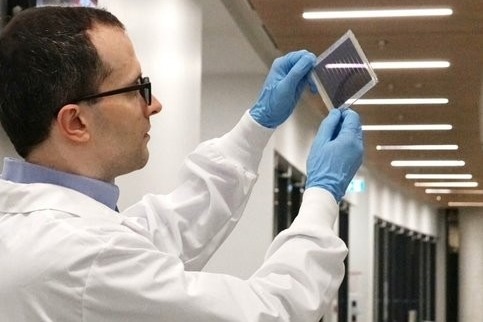Professor Vincenzo Pecunia of Simon Fraser University guided a team of over 100 internationally recognized researchers in developing a comprehensive “roadmap” to guide international efforts to convert waste energy into clean power.
 SFU professor Vincenzo Pecunia, lead author of “Roadmap on Energy Harvesting Materials,” showcasing a printable solar cell that can convert indoor light into electricity. Image Credit: Simon Fraser University.
SFU professor Vincenzo Pecunia, lead author of “Roadmap on Energy Harvesting Materials,” showcasing a printable solar cell that can convert indoor light into electricity. Image Credit: Simon Fraser University.
With the rising global energy demand and the challenges posed by climate change, it is more urgent than ever to generate green energy to preserve our planet and sustain human development.
Vincenzo Pecunia, Study Lead Author and Professor, School of Sustainable Energy Engineering, Simon Fraser University
Vincenzo Pecunia leads the Sustainable Optoelectronics Research Group.
Energy harvesting materials present a promising opportunity to generate clean electricity, ultimately enhancing the energy efficiency of our daily lives and supporting our efforts to combat climate change. These materials have the ability to convert ambient energy from various sources including light, heat, radiofrequency waves (like those from Wi-Fi and mobile signals), and mechanical vibrations.
Vincenzo Pecunia, Study Lead Author and Professor, School of Sustainable Energy Engineering, Simon Fraser University
Pecunia and 116 leading experts worldwide have published their research in the Journal of Physics: Materials to fully realize the potential of energy harvesting technology.
The roadmap brings together expert perspectives on different types of energy harvesting, recent advances, and challenges, as well as an analysis of the main performance metrics of these technologies in relation to their utmost energy conversion limits. Building on these findings, it proposes future research strategies to realize the potential of energy-harvesting materials.
This roadmap is the result of an unprecedented endeavor, marking the first time that such a large and diverse international network of energy harvesting experts—from America, Asia, Europe, and Oceania—have worked together to chart a course for the advancement of these technologies towards seamless integration into everyday objects and environments.
Vincenzo Pecunia, Study Lead Author and Professor, School of Sustainable Energy Engineering, Simon Fraser University
Smart systems are increasingly evolving, making smart homes, smart cities, smart manufacturing, and smart healthcare a reality. Sensors and systems are increasingly integrated into daily lives via devices, such as smartphones, fitness trackers, and smart home assistant technologies. These are connected to a vast network known as the Internet of Things (IoT), which constantly communicates and transfers data.
Pecunia notes, “An area of tremendous potential involves using ambient energy harvesters to sustainably power the billions of sensor nodes being deployed for IoT. By providing an eco-friendly alternative to batteries (which face materials scarcity, toxicity, and waste issues), energy harvesters could sustainably power IoT sensors.”
Pecunia’s research team has made significant contributions in this field, leading the way in the creation of clean electricity from indoor light utilizing printable semiconductors and their incorporation with printed electronics to create eco-friendly IoT sensors.
Because of their low power density, gathering energy from ambient light, vibrations, and radiofrequency waves is difficult.
Pecunia adds, “It’s essential to develop energy harvesting materials that can efficiently capture this energy and convert it to electricity. Another important priority is to develop energy harvesters that can be applied on all types of surfaces and objects, which requires energy harvesting materials that are mechanically flexible.”
The roadmap on energy harvesting technology is a collaborative and global effort to help scientists and leaders develop a strategy to accelerate this research area's development.
Pecunia concludes, “Our hope is to catalyze research efforts in energy harvesting research across multiple disciplines to ultimately deliver clean energy anywhere, anytime.”
Journal Reference
Pecunia, V., et al. (2023). Roadmap on Energy Harvesting Materials. Journal of Physics: Materials. doi.org/10.1088/2515-7639/acc550.